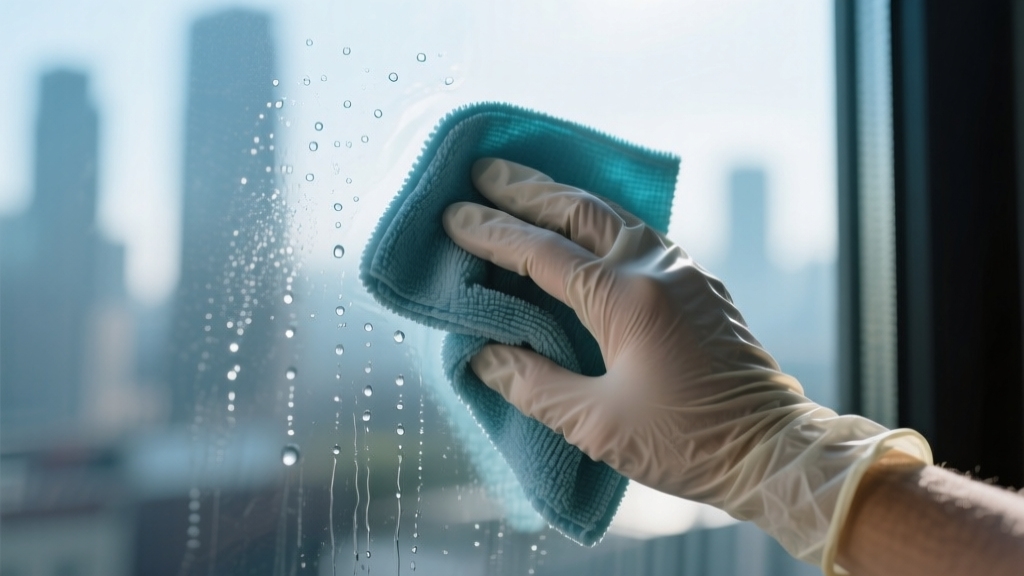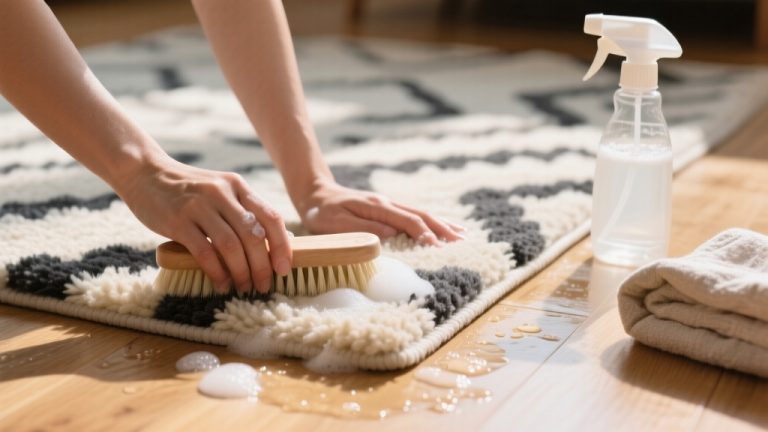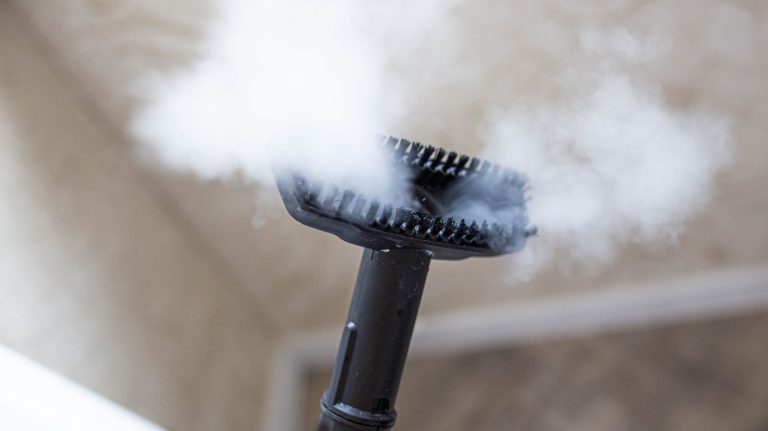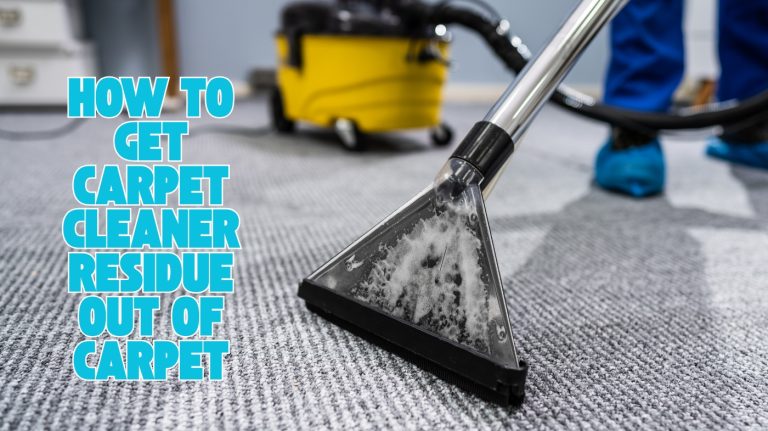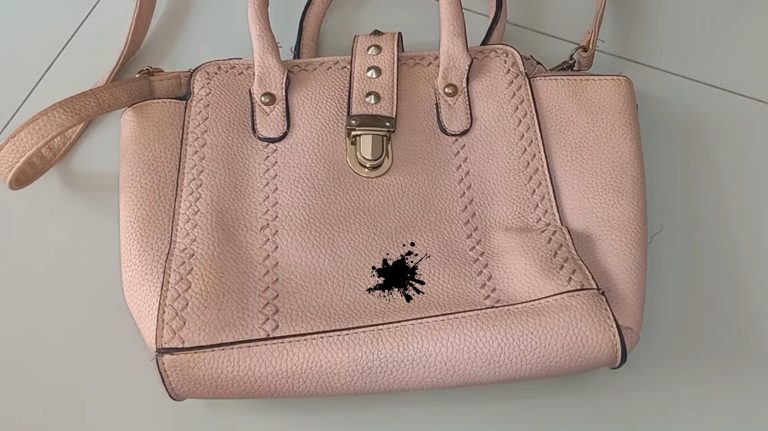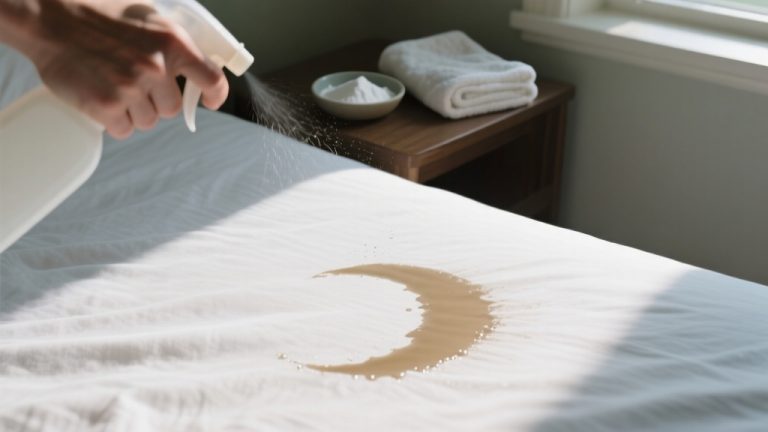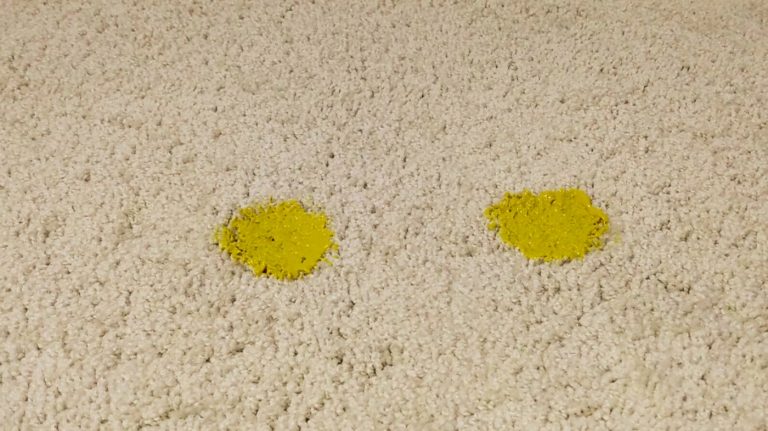Cleaning Glass With Isopropyl Alcohol: Pro Tips for Shine
When cleaning glass with isopropyl alcohol, use a 70–91% solution for ideal grease removal and quick evaporation. This prevents streaks and smears.
Spray a fine mist evenly onto a cool, dust-free surface, then wipe with a lint-free microfiber cloth in consistent strokes.
Avoid undiluted alcohol on sensitive plastics or finishes to protect surfaces. This method efficiently dissolves oils and leaves glass crystal clear.
If you want to master perfect glass cleaning, there’s more essential guidance to take into account.
Key Takeaways
- Isopropyl alcohol (70–91%) effectively dissolves oils, fingerprints, and residues on glass without scratching or damaging the surface.
- Use a 50/50 mix of isopropyl alcohol and distilled water for optimal cleaning and streak-free results.
- Apply with a fine mist spray and wipe with lint-free microfiber cloths using consistent strokes to prevent streaks.
- Work in well-ventilated areas, avoiding heat or flames, and do not use undiluted alcohol on sensitive plastics or coatings.
- High-purity IPA evaporates quickly, reducing residue and fogging, making it superior to water-only or many commercial cleaners.
Understanding Isopropyl Alcohol and Its Properties
Although you might already be familiar with isopropyl alcohol as a common household cleaner, understanding its chemical structure and properties reveals why it’s such a versatile solvent.
Discover why isopropyl alcohol’s unique chemistry makes it a powerful and versatile household solvent.
It’s a secondary alcohol with the formula C3H8O, featuring a hydroxyl group attached to the middle carbon atom. This differentiates it from its isomer n-propanol.
This clear, colorless liquid has a molecular weight of about 60.1 g/mol and a pungent odor. Its density is 0.786 g/cm³ at 20 °C, melting near −89 °C and boiling around 82.5 °C. It also forms an azeotrope with water at 87.7% concentration.
Highly miscible with water and many organic solvents, it forms an azeotrope with water at 87.7% concentration. Its polarity enables excellent solubility of oils and resins, while its rapid evaporation leaves minimal residue, underscoring its solvent efficiency.
Due to its ability to effectively break down grease and grime, it shares characteristics with fast-acting degreasers used in heavy equipment maintenance.
Why Isopropyl Alcohol Is Effective for Cleaning Glass?
Why does isopropyl alcohol work so well for cleaning glass? It dissolves oils, grease, and residues from fingerprints or adhesives more effectively than water or many cleaners.
Its molecular structure targets oily contaminants without harming the glass. You’ll appreciate how quickly it evaporates, minimizing streaks and smears, especially when used with a lint-free cloth or squeegee. This rapid evaporation is a key reason why glass cleaners containing isopropyl alcohol provide streak-free finishes.
This rapid drying also prevents residue buildup and fogging. Additionally, isopropyl alcohol reduces microbial presence on glass by disrupting membranes, enhancing cleanliness.
It’s safe for glass surfaces, avoiding scratches or chemical damage common with other products. Its affordability and accessibility make it practical for frequent cleaning. It is also cost-efficient, with IPA being inexpensive and readily available.
Optimal Concentrations of Isopropyl Alcohol for Glass Cleaning
When selecting isopropyl alcohol for cleaning glass, understanding the concentration’s impact on effectiveness and safety is crucial.
You’ll find 70% IPA offers prolonged surface contact, aiding residue removal and antimicrobial action safely. This concentration also ensures optimal germ-killing by maintaining sufficient water content for effective disinfection. Additionally, using cleaning agents with multi-surface compatibility can enhance overall cleaning performance.
Meanwhile, 91% IPA balances fast evaporation with thorough cleaning, minimizing streaks. Concentrations above 91% evaporate too quickly, reducing cleaning efficiency and increasing flammability risks.
| Concentration | Key Characteristics |
|---|---|
| 70% | Longer contact time, safer, less flammable |
| 91% | Fast evaporation, effective residue removal |
| >91% | Rapid evaporation, higher flammability, streak risk |
Choose 91% IPA for most glass surfaces to optimize cleaning without moisture damage. Reserve 70% when antimicrobial action and safety are priorities.
Comparing Isopropyl Alcohol to Commercial Glass Cleaners
Choosing the right cleaning agent for glass means understanding how isopropyl alcohol compares to commercial glass cleaners in performance and composition.
Isopropyl alcohol is an amphiphilic solvent that dissolves both water- and oil-based stains. It efficiently removes fingerprints and light oils with rapid evaporation that minimizes streaks. Isopropyl alcohol evaporates quickly, which helps keep surfaces clean and streak-free. However, it lacks many of the natural plant-based ingredients found in eco-friendly commercial cleaners that contribute to safer use and pleasant scents.
However, commercial cleaners often blend alcohol with surfactants and other solvents. This enhances dirt lifting and tackles heavy grime or adhesive residues more effectively.
While alcohol alone disinfects by killing 99.9% of germs, commercial products may include additional antibacterial agents for prolonged microbial control. Cost-wise, isopropyl alcohol is inexpensive and widely available in small volumes.
Step-By-Step Guide to Cleaning Glass With Isopropyl Alcohol
Before you begin cleaning glass with isopropyl alcohol, make sure the surface is cool to the touch and free of loose dirt or dust. Use 91% isopropyl alcohol for best results.
This concentration eliminates ghost smears and streaks more effectively than other cleaners. It is important to avoid harsh chemicals that can damage surfaces, similar to how one must handle delicate leather carefully when cleaning.
Spray the alcohol evenly, then wipe using a folded white paper towel or lint-free cloth in a consistent left-to-right pattern. Repeat until residue-free, then buff dry for a streakless shine.
| Step | Action | Tip |
|---|---|---|
| Preparation | Confirm cool, clean surface | Avoid dust for clearer results |
| Application | Spray alcohol evenly | Use 91% concentration |
| Wiping | Fold towel, wipe left-right | Prevent scratches and streaks |
| Finishing | Buff dry with clean cloth | Achieve streak-free glass finish |
Best Tools and Techniques for Applying Isopropyl Alcohol on Glass
Although applying isopropyl alcohol to glass might seem straightforward, using the right tools and techniques guarantees an even, streak-free finish and protects the surface from damage.
Choose a spray bottle compatible with 91% isopropyl alcohol featuring a fine mist for controlled, uniform coverage. Avoid bottles that previously held harsh chemicals to prevent contamination, and opt for transparent types to monitor solution levels.
When wiping, use plain white paper towels or clean microfiber cloths to avoid lint and scratches. Fold cloths for better grip and replace them frequently to prevent smudging. Using warm isopropyl alcohol can significantly improve cleaning efficiency, making residue come off faster and easier.
Before application, ensure the glass is cool and free of heavy debris. It is also important to manage moisture levels carefully to prevent damage to surrounding surfaces.
Apply lightweight, even spritzes, then wipe methodically with consistent strokes, promptly addressing hazy spots for maximum clarity.
Precautions and Surfaces to Avoid When Using Isopropyl Alcohol
Since isopropyl alcohol is highly flammable and can damage certain materials, you need to handle it with care and know which surfaces to avoid. Always work in well-ventilated areas, keeping it away from heat, sparks, or open flames.
Avoid clear plastics like touchscreens, as alcohol causes clouding or damage. Don’t apply it on painted, varnished, or finished wood frames, or rubber seals, since it can discolor or degrade these surfaces.
Be cautious using it on electronic screens only if manufacturer guidelines permit and never spray directly; moisten a cloth instead. Excess moisture and harsh chemicals can cause surface degradation on sensitive materials.
Avoid delicate, porous materials like fabric or untreated wood, which absorb and stain. Protect your skin by wearing gloves and avoid inhaling fumes.
Store isopropyl alcohol in tightly sealed containers, away from ignition sources, to minimize risks. For eco-friendly cleaning, you can also enhance homemade glass cleaners by adding rubbing alcohol to achieve a streak-free, fast-evaporating finish.
Addressing Common Challenges When Cleaning Glass With Isopropyl Alcohol
When you’re cleaning glass with isopropyl alcohol, it’s important to keep an eye on streaking. To avoid this, make sure you’re using the right dilution and technique. You’ll want to use lint-free materials, as they help give you that crystal-clear finish.
Now, if you come across any stubborn residues, don’t get discouraged! It often takes a bit of patience and maybe even a few rounds of application, especially if you’re dealing with that pesky interior glass haze. Using a 50/50 alcohol and distilled water solution is a proven effective technique for tackling tough buildup.
Oh, and one more thing—be mindful of how sensitive some surfaces can be. You definitely don’t want to accidentally damage anything nearby. So, steer clear of overspray and apply the IPA carefully.
Streak Prevention Techniques
To prevent streaks while cleaning glass with isopropyl alcohol, you need to carefully control factors like alcohol concentration, glass temperature, and wiping techniques.
Use 50%-91% IPA; dilute stronger solutions to slow evaporation. Clean cool glass indoors, avoiding direct sunlight. Wipe with lint-free microfiber cloths in consistent strokes, replacing damp or dirty cloths promptly.
The disinfectant properties of isopropyl alcohol also help sanitize the glass surface as you clean. Regular maintenance and proper cleaning techniques reduce the risk of residue buildup and contamination.
Spray alcohol evenly, wipe quickly before it dries, and apply multiple passes if needed without letting the surface dry between wipes.
| Factor | Recommendation | Reason |
|---|---|---|
| IPA Concentration | 50%-91%, dilute if above 91% | Controls evaporation speed |
| Glass Temperature | Cool | Prevents rapid drying |
| Cloth Type | Lint-free microfiber | Avoids lint/streaks |
| Wiping Motion | Left to right, consistent | Prevents missed spots |
| Drying | Quick wiping, no air drying | Stops uneven streak formation |
Dealing With Residue
Although isopropyl alcohol is a powerful cleaner, residue issues frequently arise due to impurities in lower-concentration IPA products or inadequate cleaning techniques.
To minimize residue, always choose high-purity IPA (98–100%) and avoid unspecified concentrations that may contain contaminants causing ghost smears or fogging. Additionally, it is important to prepare surfaces properly before applying IPA to optimize cleaning results.
Clean cool glass surfaces to prevent rapid evaporation, and use plain white, lint-free cloths to avoid adding fibers or dyes. Apply IPA evenly via spray bottles, allowing gradual dissolution of residues, and repeat cleaning cycles to remove persistent contaminants. Multiple applications may be necessary to fully remove all residue, especially when dealing with thick sludge.
Some oily or film-like residues resist IPA alone, requiring additional rinsing with distilled water or methanol. For complex residues from adhesives or commercial cleaners, multi-step chemical treatments may be necessary. Always ensure thorough rinsing to avoid residue buildup, especially on sensitive or coated surfaces.
Surface Sensitivity Considerations
Since isopropyl alcohol interacts differently with various glass surfaces and surrounding materials, you must consider concentration levels and dilution carefully to prevent damage.
Use 70% isopropyl alcohol diluted 50:50 with distilled water to minimize hardness deposits and reduce streaking. Avoid higher concentrations near rubber seals, plastics, or painted surfaces, as they risk degradation, discoloration, or crazing. Concentration level matters; higher concentrations are more aggressive and increase the risk of surface damage.
Be cautious with glass coatings; high-strength alcohol can impair anti-reflective or hydrophobic layers. Additionally, surface sensitivity varies depending on the type of coating and material composition.
Environmental factors like humidity, temperature, and sunlight affect evaporation rates, influencing streaks and drying uniformity. Ascertain proper ventilation to mitigate fumes and control drying patterns.
Repeated cleaning requires balancing residue removal with potential cumulative surface stress. Finally, avoid undiluted or recycled alcohol containing impurities. Never let alcohol contact sensitive window frames or coatings to maintain long-term glass integrity.
Alternative Solutions for Glass Cleaning Beyond Isopropyl Alcohol
If you’re looking for a way to clean your glass without relying on isopropyl alcohol, you might want to check out some natural options. You can whip up a simple solution using vinegar, water, and maybe even a few drops of essential oils. It’s not only effective, but it’s also eco-friendly.
Vinegar, in particular, has been shown to reduce germs effectively, rivaling many commercial cleaners in antimicrobial power. On top of that, there are some great commercial eco-friendly cleaners out there, like Biokleen and Green Llama.
These brands offer plant-based formulas that help reduce your exposure to harsh chemicals, and they still give you that streak-free shine we all want.
Natural Glass Cleaning Options
Wondering how to clean glass effectively without relying solely on isopropyl alcohol? You have several natural options that work well while being eco-friendly and non-toxic.
Here are three precise alternatives:
- Vinegar-Based Cleaner: Mix white distilled vinegar and water in equal parts. Its acidity dissolves grime and mineral deposits, leaving a streak-free shine. Enhance with natural dish soap or add cornstarch and citrus oils for extra grease removal and a fresh scent. However, it is recommended to use distilled water, especially in hard water areas, to prevent mineral deposits that can cause streaking and residue.
- Hydrogen Peroxide Solution: Use a 3% hydrogen peroxide spray directly on glass. It breaks down dirt and disinfects without residue. Store it in dark bottles to maintain potency.
- Essential Oil Additives: Add citrus oils like lemon or orange to your vinegar or peroxide mixtures. These oils boost antimicrobial effects and mask strong odors, improving both cleanliness and aroma. Using natural additives supports a human-safe, non-toxic approach to cleaning that reduces chemical exposure.
Commercial Cleaner Comparisons
Although isopropyl alcohol remains a popular choice for glass cleaning, several commercial alternatives offer specialized formulas that balance effectiveness with surface safety and environmental considerations.
You’ll find options optimized for streak-free finishes, eco-friendliness, and compatibility with coated surfaces. Consider these differences carefully when selecting a product for your needs. Using the proper techniques with these cleaners can further enhance results and minimize streaks.
| Brand | Key Features | Ideal Use |
|---|---|---|
| Biokleen Glass Cleanser | 5/5 cleaning, non-toxic, eco-friendly | Household glass surfaces |
| Bean and Lily | Neutral pH, Polyquaternium-95, streak-free | Sensitive surfaces, green choice |
| EBC Glide | Concentrated, wet longer, multi-surface safe | Professional, heavy-duty use |
| Unger Professional | Biodegradable, streak-free | Commercial, eco-conscious use |
| Windex Professional | Ammonia-free, grease removal | Tinted glass, greasy residues |
Frequently Asked Questions
Can Isopropyl Alcohol Clean Glass Without Water?
Yes, you can clean glass with isopropyl alcohol without water. Just spray 91% alcohol directly on the cool glass and wipe it with a lint-free cloth or paper towel.
The alcohol dissolves oils and grime and evaporates quickly, leaving a streak-free finish without rinsing. Avoid hot glass to prevent rapid evaporation, and don’t use it on plastics or coated glass.
Repeat wiping until the surface looks clear and spotless.
How Does Temperature Affect Isopropyl Alcohol’s Cleaning Ability?
You’ll find that warming isopropyl alcohol lowers its viscosity, boosting cleaning speed by up to 30%.
This happens because heat increases molecular movement, helping it dissolve grime and residues more effectively.
However, be cautious: higher temperatures also raise evaporation rates, which can shorten contact time and reduce effectiveness if not managed properly.
Always heat it safely and avoid flames, as isopropyl alcohol is highly flammable when warm.
Is Isopropyl Alcohol Safe for Antique or Stained Glass?
Isopropyl alcohol isn’t entirely safe for antique or stained glass. You should use it sparingly and only on small, inconspicuous spots first.
Avoid soaking or prolonged contact, as it can damage paint and delicate finishes. Instead, opt for mild detergents or ammonia solutions, which are gentler.
Always handle the glass carefully, use soft cloths, and rinse afterward to prevent residue buildup that could dull the surface over time.
Can Isopropyl Alcohol Remove Hard Water Stains From Glass?
You can remove mild hard water stains with isopropyl alcohol by spraying a diluted solution, letting it sit briefly, and wiping gently with a soft cloth.
You can dissolve oils, reduce streaks, and maintain glass clarity. However, you can’t expect isopropyl alcohol to tackle deep mineral deposits effectively.
For stubborn stains, you’ll need stronger acids or abrasives, but alcohol works well for light buildup and routine maintenance without damaging glass.
Does Isopropyl Alcohol Affect Window Tint Films?
Yes, isopropyl alcohol can affect window tint films, especially if it’s highly concentrated or used excessively.
You should dilute it to 70-91% and apply it sparingly with a microfiber cloth, avoiding direct sprays to prevent softening the adhesive or damaging the film.
Always test a small, hidden area first.
Using it occasionally and gently helps maintain tint clarity, but overuse risks peeling, discoloration, or fading, especially on older or lower-quality films.
Shine Smarter: Use Isopropyl Alcohol for Effortless Clarity
You might expect stubborn streaks to cling like fog on a windowpane, but with isopropyl alcohol, they vanish like morning mist under the sun.
Its precise concentration and careful application transform smudges into crystal clarity, unlike many commercial cleaners that leave residue behind.
By choosing the right tools and respecting precautions, you’ll achieve spotless glass surfaces that gleam sharply, proving that a simple solution can outshine complex alternatives every time.

